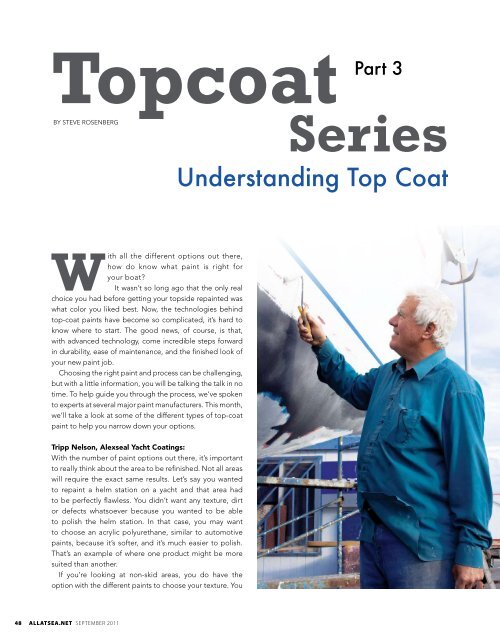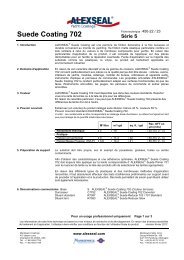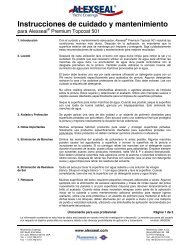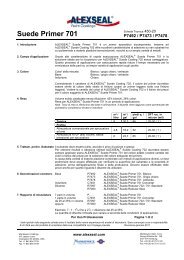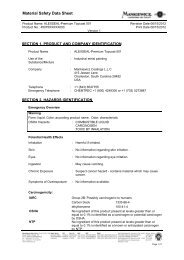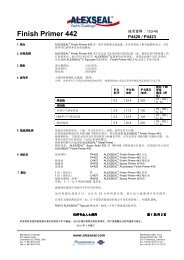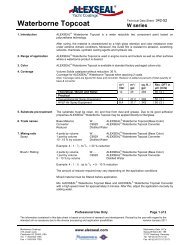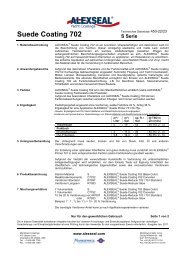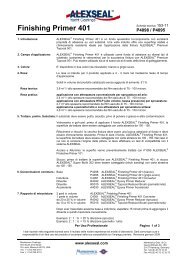Topcoat Series: Part 3, Understanding Top Coat - Alexseal
Topcoat Series: Part 3, Understanding Top Coat - Alexseal
Topcoat Series: Part 3, Understanding Top Coat - Alexseal
You also want an ePaper? Increase the reach of your titles
YUMPU automatically turns print PDFs into web optimized ePapers that Google loves.
<strong><strong>Top</strong>coat</strong><br />
<strong>Part</strong><br />
by steve rosenberg<br />
3<br />
<strong>Series</strong><br />
<strong>Understanding</strong> <strong>Top</strong> <strong>Coat</strong><br />
With all the different options out there,<br />
how do know what paint is right for<br />
your boat<br />
It wasn’t so long ago that the only real<br />
choice you had before getting your topside repainted was<br />
what color you liked best. Now, the technologies behind<br />
top-coat paints have become so complicated, it’s hard to<br />
know where to start. The good news, of course, is that,<br />
with advanced technology, come incredible steps forward<br />
in durability, ease of maintenance, and the finished look of<br />
your new paint job.<br />
Choosing the right paint and process can be challenging,<br />
but with a little information, you will be talking the talk in no<br />
time. To help guide you through the process, we’ve spoken<br />
to experts at several major paint manufacturers. This month,<br />
we’ll take a look at some of the different types of top-coat<br />
paint to help you narrow down your options.<br />
Tripp Nelson, <strong>Alexseal</strong> Yacht <strong>Coat</strong>ings:<br />
With the number of paint options out there, it’s important<br />
to really think about the area to be refinished. Not all areas<br />
will require the exact same results. Let’s say you wanted<br />
to repaint a helm station on a yacht and that area had<br />
to be perfectly flawless. You didn’t want any texture, dirt<br />
or defects whatsoever because you wanted to be able<br />
to polish the helm station. In that case, you may want<br />
to choose an acrylic polyurethane, similar to automotive<br />
paints, because it’s softer, and it’s much easier to polish.<br />
That’s an example of where one product might be more<br />
suited than another.<br />
If you’re looking at non-skid areas, you do have the<br />
option with the different paints to choose your texture. You<br />
48 allatsea.net September 2011
Interlux Half boat project: Office<br />
and factory workers restored half<br />
of this boat to show what two part<br />
polyurethane can do.<br />
Photo courtesy of Interlux Yacht Finishes<br />
can add a plastic bead to the paint to obtain a fine non-skid<br />
surface if you are going to be sitting on the area and you’re<br />
not worried about the safety aspect. You can also choose<br />
to have a coarser non-skid area such as on the bow deck.<br />
You can tailor the non-skid surface with these polyurethane<br />
paints just by adding different amounts of beads to them.<br />
Jack Hickey, Blue Water Marine Paint:<br />
Deciding on the finished look you’re after really drives<br />
the steps you’ll take choosing a top-coat product.<br />
Some finishes require special application methods and<br />
specific skills such as spraying or tent drying. If you want<br />
the maximum in longevity and appearance and you’ve<br />
chosen a polyurethane finish and the appropriate system<br />
of primers and filling/fairing compounds, you should be<br />
asking for the marina, boatyard or painting contractor for<br />
their experience with spray techniques and any available<br />
testimonials to their experience, such as previous boats<br />
he has repainted. In general, the service or use of the<br />
boat hull to be painted has little to do with the choice<br />
of topcoat system; however, the life expectancy, inherent<br />
durability and both initial and longer-term appearance<br />
usually drives the choices.<br />
One thing to remember when planning your painting<br />
project is that your choice of topcoats, primers and compounds<br />
should all come from a single manufacturer if possible.<br />
This can alleviate any liability questions incurred as a result of<br />
a paint-system failure. Failures are rare but it is always a good<br />
idea to stay with one vendor for the products to be applied as<br />
well as the marine, boatyard or contractor used.<br />
Jim Seidel, Interlux Yacht Finishes:<br />
Marine alkyd enamels are single-part paints. They use<br />
synthetically produced resins that give good coverage and<br />
hide. They are easy to use and flow out well. Another option<br />
is a single-package polyurethane that uses a blend of alkyd<br />
and urethane resins that are more durable than marine alkyd<br />
enamels. They have excellent gloss, gloss retention and<br />
provide excellent abrasion resistance. Finally, you have twopart<br />
polyester polyurethane products with a hard, abrasionresistant<br />
coating with high gloss and extreme durability. Twopart<br />
polyurethanes come in two types, polyester polyurethane<br />
and acrylic polyurethane. Polyester polyurethanes were<br />
originally developed for the aircraft industry and are hard<br />
abrasion resistant coatings that are very durable but are<br />
difficult to repair. Acrylic polyurethanes were developed<br />
for the automotive market where there was need for a hard<br />
coating that was easier to repair if it became scratched or<br />
nicked. They dry faster than polyester polyurethanes and<br />
can be buffed for a higher gloss if necessary. While polyester<br />
polyurethanes are the most popular type used in the yacht<br />
market, acrylic polyurethanes are used because of ease and<br />
speed of application and their ability to be repaired easily.<br />
Coming next month: We’ll look at the best ways to<br />
maintain your new paint job and different methods of<br />
removing stains and minor damage.<br />
Steve Rosenberg is the former editorial director of Boating<br />
World magazine and now writes exclusively about boating<br />
and yachting.<br />
September 2011 allatsea.net 49


